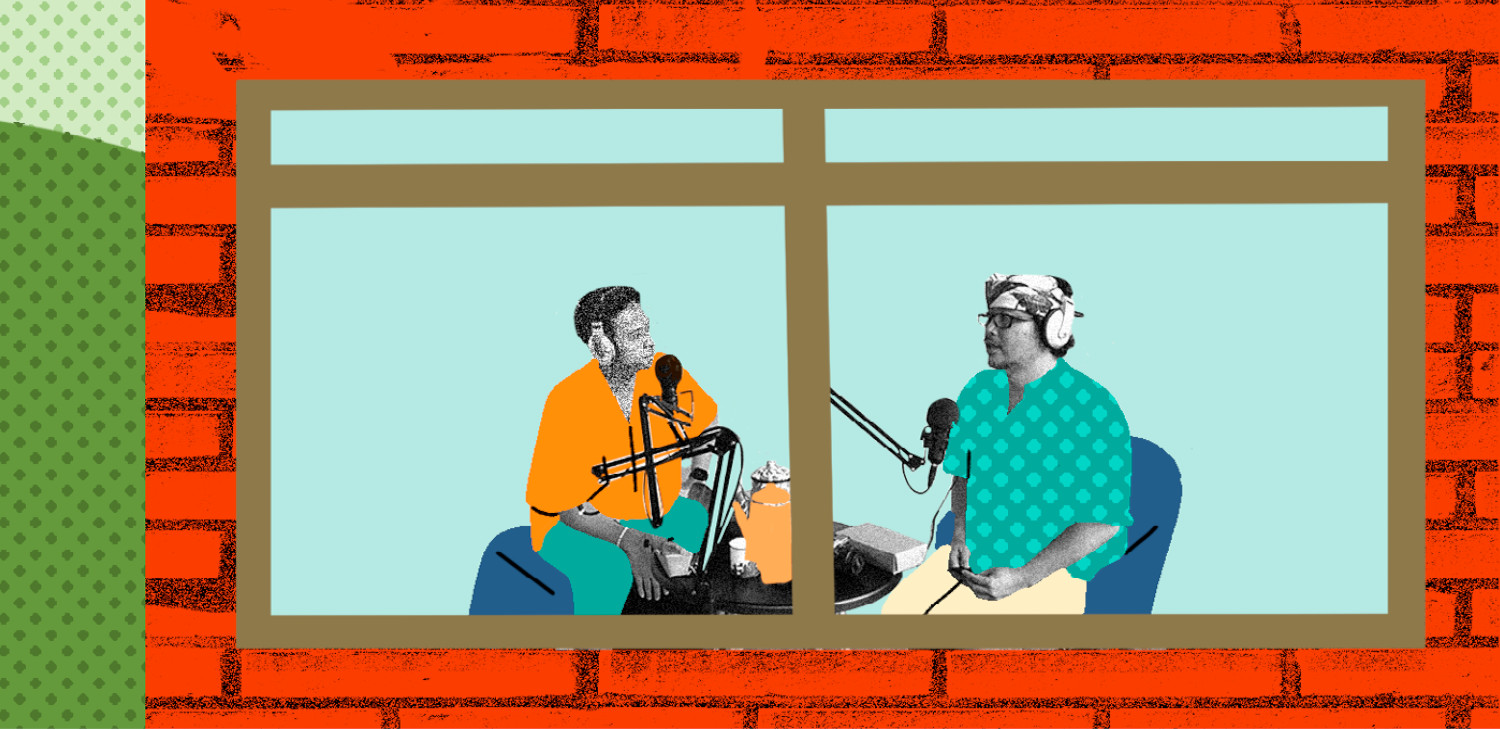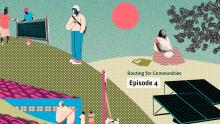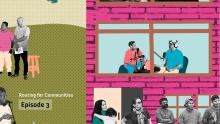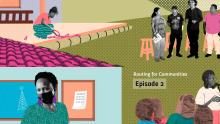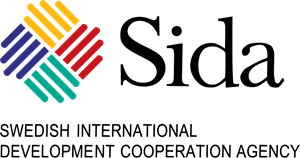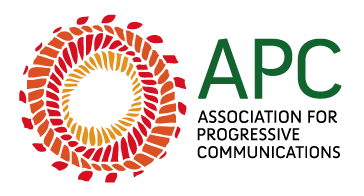#6 Community networks enabling art, culture and communication in Indonesia
Let's go to Indonesia together to meet the Common Room Networks Foundation and its co-founder Gustaff Iskandar. This is a project that works with art, culture, communication and new technologies. Gustaff helped build the community network in Ciptagelar Traditional Village, in West Java. According to him, there are around 12,000 villages that are still disconnected in Indonesia, and not only from internet access – more than half of them still don't have any adequate source of electricity.
In this episode, we also travel to Australia. There, we spoke with Carlos Rey-Moreno, from the Association for Progressive Communications (APC). He's one of the coordinators of the Local Networks initiative and works to promote enabling policy and regulation for community-led communications models.
“Routing for Communities” is a 12-episode podcast. Here you will be able to listen to the life stories of people who build inspiring community-led projects around the world.
Histories and voices that are intertwined, connected by one thread: building internet and communication community networks.
Hello! My name is Renata Porto and I am the host of this 12-episode season around community-led initiatives on internet and communication. I'm recording this episode in a studio located in the city of São Paulo, Brazil.
In this sixth episode, I'll cross over to the other side of the world to tell you a story from Asia.
Let's go to Indonesia together to meet the Common Room Networks Foundation and its co-founder Gustaff Iskandar. This is a project that works with art, culture, communication and new technologies.
“The internet is not only a new platform that can be utilized by the local communities to communicate and to access information, but also it can be very useful to enhance artistic and cultural expressions.”
In this episode, we'll also travel to Australia. There, we spoke with Carlos Rey-Moreno, from the APC – Association for Progressive Communications. He's one of the coordinators of the Local Networks initiative and keeps up with the projects in Indonesia.
“This leader, he said: ‘Okay. I'm gonna create a network in the community whereby I am gonna incentivize people to recycle more’.”
So come with me!
Routing for communities: An audio journey tracing community connectivity around the world.
It was eight o'clock at night in São Paulo when our team started the video call of the interview. But in the city of Bandung – in Indonesia – it was six in the morning.
“-Hi, Gustaff?
Hello, good morning.
-Good morning. How are you?
I'm good, I'm good.
-Thank you so much for accepting this interview.
No worries. There's something I have to do this morning anyway, so yeah.
-But it's too early for you.
Yeah, it is a little bit early.”
Despite the early morning, our interviewee was in a good mood and had a smile on his face at his home. In the camera image, we could see a brown curtain in the background and some guitars.
“My name is Gustaff, my second name is Gustaff Harriman Iskandar. I work in the Common Room. It's a nonprofit organization working in the flopping open platform for art, culture, and ICT Media in Bandung.”
Ah, just so you understand; this “ICT” mentioned by Gustaff is the abbreviation for Institute of Science and Technology.
Gustaff has his trajectory marked by art. He has a degree in the Arts and has dedicated himself to several projects in this area, such as managing exhibitions, and as a writer for a magazine on contemporary art, design, music and technology.
In the early 2000s, he and a group of friends created the Bandung Center for New Media Arts, which carried out artistic works in Indonesia. In 2006, the project changed into what is now the Common Room Networks Foundation. From then on, it began to work with communities in artistic and cultural activities, combining the use of the internet and digital media as tools to promote freedom of expression, technological innovations and creativity.
A new moment, which continues to this day, began in 2013. At that time, Common Room began to operate in other areas of Indonesia, besides Bandung.
“From there, we learned that we have quite a huge gap and disparities in terms of the development process in Indonesia. And then we feel that we should try to expand our outreach not only by working in an urban context but also try to include rich collaborations between people in urban and rural areas. So from there, our initiative on community networks started to develop, especially when we started to do projects with Ciptagelar, indigenous community in West Java, while trying to set up the local internet infrastructure in the region.”
Gustaff currently lives in the city of Bandung, capital of the province of West Java. But 200 kilometres away, in a journey that takes more than seven hours by car, is Ciptagelar Traditional Village, in Sukabumi Regency, also in West Java. There, Gustaff helped build a community network.
The local population is around 30,000 people, who live in more than 500 villages across Halimun Mountain. The name Ciptagelar comes from the Sundanese word sepuh, which means "old" and refers to a way of life based on ancestral traditions, with a harmonious relationship with nature and protection of the environment.
“The people in that region have a very interesting and unique tradition, a traditional farming culture. The location is in the deep forest of Halimun, Salak National Park. I think the forest itself is a very important tropical forest reserve in West Java. As you probably notice, West Java is one of the fastest growing regions in Indonesia and to have a tropical forest with a very good condition is very special.”
The majority of the population of Ciptagelar Traditional Village are farmers, and subsistence is based on the cultivation of rice. The region has many traditional foods, such as tape ketan, which is made from a type of fermented rice with a sweet and sour taste; and wajik, a sweet made from rice, sugar and coconut milk. All this rice culture is also reflected in the local art.
The song you just heard also comes from the local tradition. It was sent to us by Gustaff after the interview by email.
He says the song is called “Keupat Reundang”, and “it is performed by Ciung Wulung traditional music group at Kasepuhan Ciptagelar Village.”
Gustaff explains that “the song consists of music made from Angklung Buncis, a bamboo musical instrument which is played together with Dogdog, a bamboo percussion that usually uses deer skin as its membrane. Two ladies are singing about the story of daily lives of villagers to accompany the Nganyaran rituals. This particular ritual is an initiation of annual activity in pounding the rice that was harvested every year.”
In a territory so attached to ancestral traditions and in the midst of mountains and a dense forest, the need for access to information and communication is crucial, also to strengthen ties between villages and encourage tourism to this region.
Gustaff says that it was the leader of the indigenous community who asked them if it would be possible to build a local infrastructure, “from their own hands”, to access the internet. The challenge was accepted by the Common Room team, and starting in 2016, they began running a series of experiments. Two years later, based on collaboration with a local ISP (Internet Service Provider) based on the outskirts of Bandung, they managed to provide some internet service and access to communication and information.
But a step towards working on new internet access technologies needed to be taken with the community. In 2019, Common Room began working with community networks in collaboration with a Local Networks initiative, led by the Association for Progressive Communications (APC) and Rhizomatica.
The first project was meant to expand internet access in one village and distribute it to five neighbouring villages. Training was also carried out with community members, especially young people. The next step was to work on the internet infrastructure.
Today the project is much bigger. According to Gustaff, the internet is expanding to about 37 different villages, with about 1,000 users every day.
There is also training for the use and maintenance of the infrastructure. Some of the foundations that guide this whole process are a low-cost, low-maintenance technology that is easy to learn and has local support – and also with low energy use, which is provided by micro-hydroelectric plants installed in the region's rivers.
“The digital divide challenges in Indonesia is quite complex, not only because of its geographical context. You probably know that in Indonesia we have maybe around 17,000 different Islands, with different conditions and challenges. There are highlands, coastal regions, forest areas, remote islands, and so on, and so on. So this kind of geographical setting is quite unique, and we have to find specific ways on how to develop the internet infrastructure in order to provide connectivity for people in many different Islands”.
Indonesia has over 273 million inhabitants. According to Gustaff, there are around 12,000 villages that are still disconnected, not only from internet access. More than half of them still don't have any adequate source of electricity.
In addition, there are differences in the price of broadband internet service between regions, as internet is cheaper in large urban centres while in rural areas it is more expensive.
Infrastructure and internet access are just a part of the work developed by Common Room with the Ciptagelar community. Workshops are also held for artistic and audiovisual production on local culture, the rights of indigenous communities, as well as digital literacy to deal critically with new technologies.
“We have been learning a lot that the community network is not merely about the physical internet infrastructure per se. In order to have an appropriate approach on internet developments among rural communities, we also need to conduct a cultural approach and recognize local culture and traditions, because the internet is not only a new platform that can utilize by the local communities to communicate and to access information, but also it can be very useful to enhance the artistic and cultural expressions”.
We say goodbye to Indonesia with this song performed by children from Ciptagelar. They participated in music and composition workshops and had a video produced in a digital narrative workshop, both held by Common Room. This song is called “Sakola Adat” or “Customary School”, and the lyrics were written by Aki Dai, a traditional local artist. The lyrics talk about how children learn from indigenous peoples to maintain ancestral values and defend the customs and culture of the community.
Not far from there, we travel from Indonesia to Australia. That's where our second interviewee in this episode lives.
“Hi, my name is Carlos Rey–Moreno, I am originally from Spain although I've been a bit all over. Currently I live in Australia and I work for the Association for Progressive Communications commandeering the program on local access networks and leading the LocNet initiative.”
This initiative Carlos is referring to is Local Networks, or just LocNet. It is led by APC in partnership with the organisation Rhizomatica. This project directly supports the work of community networks and other local community-based connectivity activities, especially in Africa, Asia and Latin America.
As part of LocNet, for example, the project of the National Schools of Community Networks takes place, which we have already talked about in other episodes. It focuses on supporting and training people so that they can – together with their communities – create, develop and consolidate community networks. Indonesia is one of the countries receiving this project, along with South Africa, Kenya, Nigeria and also Brazil, with financial support from the UK Government’s Digital Access Programme.
In each country, traits of culture, legislation and social relations influence the development of schools and community network projects. In the case of Indonesia, Carlos tells us a story that is inspiration for other processes, for mixing financial self-sustainability, connectivity and environmental preservation.
“The villages have their own funding, their own funds, to implement projects, but at the same time, in Indonesia, there is one thing that is called waste banks, which actually they can receive money in exchange of recycling. In Bali, one of the organizations that are part of the School of Community Networks in Indonesia, that Common Room is implementing, so this person, this leader, he said: ‘Okay. I'm gonna create a network in the community whereby I am gonna incentivize people to recycle more. So if they recycle more they will be able to use the internet more in the network that we are going to build in the village’. Because he was realizing that the beach was more and more polluted with plastics, that the village was more and more polluted with plastic. So, that sense of circular economy, of that element of we rely on the ocean, we rely to a certain extent on tourism and we need our village to be clean. Not only in relation to that, but in relation to the environment.”
Indonesia, like other countries in the Global South, has a gap in telecommunications infrastructure between urban and rural areas, reflecting social and economic imbalances.
To deal with this digital divide, it is necessary to influence also public policies and regulatory frameworks so they facilitate access and creation of these services by communities. This is an area in which Carlos is also focused at APC.
“Telecommunications is a highly regulated space where in order to provide services you need to pay rather hefty fees. I think it's on the interest, I guess of everyone if we want to close the digital divide and to understand, to see that there is the need to create a more enabling environment for the small operators that don't want to provide services outside their abilities, that they don't want to become a multinational company and that the same rules do not apply and cannot apply in terms of fees, in terms of bureaucracy, in terms of taxes. If you want to incentivize that those communities are the ones sold in their own problems, that in many cases the market cannot solve for themselves. So, thinking that other types of regulations, other types of incentives are required to make sure that everyone is connected, it is necessary and it's possible. There are many examples of countries where regulators and policy makers are understanding this need and are really transformed in the regulatory framework to make a space for this or their complementary types of operators, which are very much needed.”
And we come to the end of our sixth episode of the season. As always, I hope the stories that were told by voices from different parts of the world were a source of learning and hope. And that the initiatives shared in this podcast lead us to act, together and collectively, in support of community-led initiatives.
If you'd like to learn more about the Common Room, check out the link in the description of this episode on your podcast player. We will add links to materials about ways to create a more enabling policy and regulation environment for community networks as well.
If you’ve liked this episode, please recommend it to those you know will appreciate it as well.
Uou can follow the season on the main podcast platforms or on APC’s website: routingforcommunities.apc.org.
We’ll meet again soon, with new experiences and stories from community-led networks that are also connected to
In the seventh episode, we get to know a project directly from the largest city in Brazil, São Paulo. In this episode, community networks will intertwine with gender, race and class reflections. Don't miss it!
By the way, you can join our Telegram channel so you don't miss any episodes. The link is also in the description of this episode on podcast platforms. We send updates firsthand there!
You listened to the sixth episode of “Routing for communities: An audio journey tracing community connectivity around the world”. This is the podcast of the Local Networks initiative, a collective effort led by APC and Rhizomatica. Production: Rádio Tertúlia.
Thanks and see you next time!
Credits
This podcast is an initiative from the Association for Progressive Communications (APC) and Rhizomatica, produced by Rádio Tertúlia.
Script and production: Vivian Fernandes.
Presentation: Renata Porto.
Editing: Beatriz Pasqualino.
Sound: Lua Gatinoni.
Coordination: Beatriz Pasqualino and Débora Prado.
Consulting Board: Bruna Zanolli, Cynthia El Khoury, Daniela Bello, Flavia Fascendini, Kathleen Diga and Nils Brock.
Translation: Marcio Miranda.
Illustration: Gustavo Nascimento.
Web design: Avi Nash and Cathy Chen.
